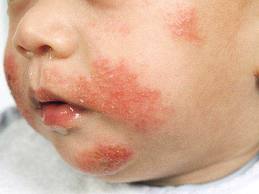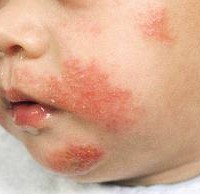Baby atopic dermatitis or eczema is a skin inflammatory condition that leaves the skin itchy, dry, and scaly. It causes rashes on different areas of the body, but it usually appears on the face, on the hands and the feet, behind the knees and inside the elbows.
Atopic dermatitis eczema is a disease of childhood. In fact, 10% of infants around the globe suffer from from baby atopic dermatitis. 65% of these babies show signs of the condition during the first year of life while 90% experience it within the first five years. More often than not, infants are affected when they are 2 to 6 months old. The symptoms diminish when they are 18 months until they are 3 years old.
A variety of circumstances triggers baby atopic dermatitis. Below are only some of the factors why this disease haunts our little ones.
1. One main reason may be accredited to family heredity. If your family has a history of allergies, there is a major possibility that your baby will acquire such skin condition.
2. Moisture from sweat, saliva, or milk can irritate the skin of the baby.
3. Exposure to too much heat can also aggravate the condition your baby experiences.
4. Infants should be kept away from dusty and smoky places, for obvious reasons that babies may acquire whatever germs these elements bring.
5. The house dust mites and animal dander are an aggravating factor for atopic dermatitis, which often associates, as a child grows older with astma and hay fever
6. Even detergents and soaps can trigger baby atopic dermatitis. In fact, when cleaning the baby, the water must be steered clear of bubble bath.
7. Children with known allergies to most common allergens: dairy, wheat, egg or peanut have a higher risk of developing atopic dermatitis. The major food allergens: egg, peanut, milk, wheat and soy account for 91% of the allergies
Remedies for baby atopic dermatitis

• It is reported that breast feeding could reduce the risk of AD also it has a protective effect on the development of various food allergies
• Keeping the baby cool and free from unclean moisture such as sweat, milk, among others.
• Keeping bathes short and lukewarm to keep the baby’s skin from drying.
• Applying cool compresses followed by a moisturizer to the affected area when a skin flare-up occurs.
• Keeping him away from cigarette smoke.
• Grooming the baby with smooth and soft fabric and avoiding scratchy ones such as wool and the like.
• Alcohol and astringents found in skin care products may be drying and exposure to the should be minimized. Use only soap specifically made for sensitive, atopic skin.
